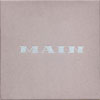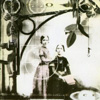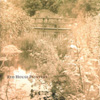 Although many of these songs were made available previously on an identically named and highly limited edition album from 2004, this is not technically a reissue as the material has been reworked and the album has been quite expanded compared to the original. The quiet white light at the core of the music has been refracted and split into a rainbow of strings and woodwind, all arranged by Maxim Moston (best known for his work with Antony and the Johnsons and Rufus Wainwright). The sweetness of the songs become even more pronounced with its small orchestral backing, although Moston does not over-clutter Dee’s songs and allows her singing and piano to take center stage.
Although many of these songs were made available previously on an identically named and highly limited edition album from 2004, this is not technically a reissue as the material has been reworked and the album has been quite expanded compared to the original. The quiet white light at the core of the music has been refracted and split into a rainbow of strings and woodwind, all arranged by Maxim Moston (best known for his work with Antony and the Johnsons and Rufus Wainwright). The sweetness of the songs become even more pronounced with its small orchestral backing, although Moston does not over-clutter Dee’s songs and allows her singing and piano to take center stage.
Two new shows just for you. We have squeezed out two extended release episodes for this weekend to get you through this week. They contain mostly new songs but there's also new issues from the vaults. The first show features music from Rider/Horse, Mint Field, Robert Aiki Aubrey Lowe, Anastasia Coope, ISAN, Stone Music, La Securite, Bark Psychosis, Jon Rose, Master Wilburn Burchette, Umberto, Wand, Tim Koh, Sun An, and Memory Drawings. The second episode has music by Laibach, Melt-Banana, Chuck Johnson, X, K. Yoshimatsu, Dorothy Carter, Pavel Milyakov, Violence Gratuite, Mark Templeton, Dummy, Endon, body / negative, Midwife, Alberto Boccardi, Divine. Cow in Maui from Veronika in Vienna. Get involved: subscribe, review, rate, share with your friends, send images! |



 This is one of the cases where the artists’ environment clearly comes across in their recorded output. Hailing from Norway, the duo of Pjusk weave digital soundscapes that are cold and icy, yet have an inviting warmth to them, like a fireplace heated cabin amongst the frozen tundra. Their second album is a gloriously minimal piece of subtle melody and texture that reveals more the closer it is listened to.
This is one of the cases where the artists’ environment clearly comes across in their recorded output. Hailing from Norway, the duo of Pjusk weave digital soundscapes that are cold and icy, yet have an inviting warmth to them, like a fireplace heated cabin amongst the frozen tundra. Their second album is a gloriously minimal piece of subtle melody and texture that reveals more the closer it is listened to. Hz was initially a series of six EPs, released monthly, then compiled into a six disc box set, and later a two disc compilation. In my opinion, the then-duo of Robert Hampson and Scott Dawson reached the highest peak in their quest to take the sound of the electric guitar as far as it could go. Evenly split between astronomical ambient abstraction and a nascent take on post rock, this set was the final one where the duo’s history as Loop was still shining through. The result is two hours of the best experimental rock and ambient drone in my own personal collection.
Hz was initially a series of six EPs, released monthly, then compiled into a six disc box set, and later a two disc compilation. In my opinion, the then-duo of Robert Hampson and Scott Dawson reached the highest peak in their quest to take the sound of the electric guitar as far as it could go. Evenly split between astronomical ambient abstraction and a nascent take on post rock, this set was the final one where the duo’s history as Loop was still shining through. The result is two hours of the best experimental rock and ambient drone in my own personal collection. Miguel De Pedro continues to find ways to make his already motley discography more diverse and unpredictable. After manipulating and distorting the sounds of Mille minimal techno, glitch, techno, rave, and having an almost intimate encounter with ambient something-or-other, Kid606 is now taking a stab at analog noise. Without his signature beats and usual goofiness to aid him, Miguel sounds a little lost. But, even with its numerous lulls and head-scratching moments, Songs About Fucking Steve Albini is one of the better things the Kid has released in the last few years.
Miguel De Pedro continues to find ways to make his already motley discography more diverse and unpredictable. After manipulating and distorting the sounds of Mille minimal techno, glitch, techno, rave, and having an almost intimate encounter with ambient something-or-other, Kid606 is now taking a stab at analog noise. Without his signature beats and usual goofiness to aid him, Miguel sounds a little lost. But, even with its numerous lulls and head-scratching moments, Songs About Fucking Steve Albini is one of the better things the Kid has released in the last few years. Scorn's third album was a groundbreaking and seminal release, as Napalm Death’s former rhythm section finally shook loose the last vestiges of their metal past to attain the sinister strain of dub that they came to be known for. Unfortunately, it was also one of the last times that things went well for the project, as Mick Harris would soon be hit by the mercurial Nick Bullen's departure, creative differences with Earache, and a precipitous decline in the popularity of the isolationism genre.
Scorn's third album was a groundbreaking and seminal release, as Napalm Death‚Äôs former rhythm section finally shook loose the last vestiges of their metal past to attain the sinister strain of dub that they came to be known for. Unfortunately, it was also one of the last times that things went well for the project, as Mick Harris would soon be hit by the mercurial Nick Bullen's departure, creative differences with Earache, and a precipitous decline in the popularity of the isolationism genre. Bill Fay says David Tibet is probably the only person who would have released this 2CD set. The first disc covers demos and live material from 1970-1971 with Fay’s singing, piano, guitar, bass, and drums combining at times to astonishing effect. The second, lighter disc, recorded at home in 2008, begins with Fay's vocals added to a Michael Cashmore instrumental from The Snow Abides and ends with a song written by his brother, John Fay.
Bill Fay says David Tibet is probably the only person who would have released this 2CD set. The first disc covers demos and live material from 1970-1971 with Fay’s singing, piano, guitar, bass, and drums combining at times to astonishing effect. The second, lighter disc, recorded at home in 2008, begins with Fay's vocals added to a Michael Cashmore instrumental from The Snow Abides and ends with a song written by his brother, John Fay. Mark Kozelek has recorded several brilliant albums over the last two decades, but this 1993 collection of odds and ends left over from the Red House Painters' first eponymous album is generally not considered one of them. Nevertheless, it remains of his most strangely compelling releases to date and features some of the most achingly perfect distillations of everything that made his early work so unique and powerful.
Mark Kozelek has recorded several brilliant albums over the last two decades, but this 1993 collection of odds and ends left over from the Red House Painters' first eponymous album is generally not considered one of them. Nevertheless, it remains of his most strangely compelling releases to date and features some of the most achingly perfect distillations of everything that made his early work so unique and powerful. From the joyous opening song to the last note of the final track I am captivated by the fierce instrumentation and solemn warmth of Slow Six. Serious yet playful they remind me that I don't need to jump out of an airplane or ski down the alps to experience the rush of exhilaration; all I have to do is turn on my stereo and put on this beautiful record.
From the joyous opening song to the last note of the final track I am captivated by the fierce instrumentation and solemn warmth of Slow Six. Serious yet playful they remind me that I don't need to jump out of an airplane or ski down the alps to experience the rush of exhilaration; all I have to do is turn on my stereo and put on this beautiful record. Robert Lowe seems to be the busiest man in music, as well as his own Lichens project he is popping in up in so many different bands: The Cairo Gang, Om and Twilight (the metal band, not the film) to name a few. On this second collaboration with Rose Lazar, Lowe again contributes the music and the duo worked together on the artwork. Musically, it is a far cry from the Robert Lowe I already know; soft synthesiser rhythms and melodies are the order of the day. It is entrancing, comforting and magnificent all in one go.
Robert Lowe seems to be the busiest man in music, as well as his own Lichens project he is popping in up in so many different bands: The Cairo Gang, Om and Twilight (the metal band, not the film) to name a few. On this second collaboration with Rose Lazar, Lowe again contributes the music and the duo worked together on the artwork. Musically, it is a far cry from the Robert Lowe I already know; soft synthesiser rhythms and melodies are the order of the day. It is entrancing, comforting and magnificent all in one go.
